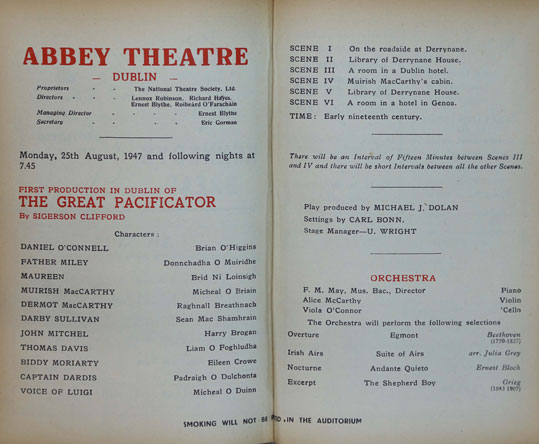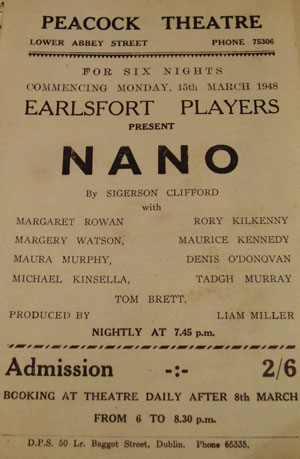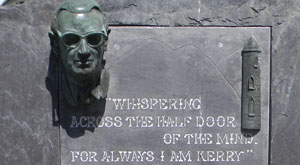THE GREAT PACIFICATOR BY SIGERSON CLIFFORD
Published in Issue 1 (January/February 2023), Reviews, Volume 31By Fiona Brennan
The playwright, poet and short-story writer Sigerson Clifford is perhaps best known as the author of the ballad ‘The Boys of Barr na Sráide’. He was born in Cork City in 1913, but his parents, Mary Anne Sigerson and Michael Clifford, were originally from Cahersiveen, Co. Kerry, and returned there with their young family some months after Sigerson’s birth. Growing up on the Iveragh Peninsula, Sigerson spent considerable time with his grandfather, Ned Clifford, a well-known storyteller from whom he inherited his love of the Gaelic oral tradition. By the time he moved to Dublin in 1943 to join the Civil Service he was enjoying considerable success as a writer. Although he never gave up his full-time employment, he continued to write fiction and newspaper columns and was the author of more than a dozen plays.

Above: Programme of the 1947 Abbey Theatre production of Sigerson Clifford’s The Great Pacificator. (Abbey Theatre Archive)
By the time Sigerson married Cork woman Shelia Eady in 1945 his playwriting career was already gathering momentum. His initial success was in 1944, when his full-length play Nano, based on the theme of land-grabbing, won the New Manuscripts’ Award at the Kerry Drama Festival in Killarney. Two years later, in 1946, he won the New Manuscripts’ Award at the Louth Drama Festival with The Great Pacificator, a historical drama based on the life of Daniel O’Connell, ‘the Liberator’. The festival adjudicator, Ria Mooney, who later became the Abbey Theatre’s first female producer, declared it one of the best she had read in some time.
This full-length play is set between 1845 and 1847 (‘Black ’47’). Written in six scenes, its dramatic action moves between rural and urban settings, including the Iveragh Peninsula, the Derrynane estate and the cities of Dublin and Genoa, and concludes with O’Connell’s death. The play’s central theme is that of the increasing tensions between O’Connell, who is staunchly anti-violence, and the more aggressively focused Young Ireland movement. O’Connell warns the Young Ireland leaders, Thomas Davis and John Mitchel, against enticing an ‘… untrained peasantry to rush into battle against the might of the British Empire’. In Scene 4, which is set in Dublin, Davis and Mitchel are adamant that ‘… Ireland has outgrown O’Connell’. They cast aspersions on the Kerryman’s rhetoric, as they look down from an upstairs window at O’Connell, who is addressing his supporters.

Above: Poster for a 1948 production of Clifford’s play Nano, for which he received the New Manuscripts’ Award at the Kerry Drama Festival in 1944. (Dolmen Press Archive, Wake Forest University, NC)
In August 1947 the Abbey Theatre produced The Great Pacificator to great acclaim. Reviewers identified Clifford’s deft writing skill as demonstrating a ‘quality of intellect’ and a ‘warmth of humanity’. An Irish Press reviewer observed how ‘… word by word [Clifford] chisels … the story of clashing, diametrically opposed ideals’. Critics singled out the play’s final scene, in which Clifford utilises a cinematic-like ‘flashback’ mode to intensify the mood. As O’Connell lies dying in a room in Genoa, he is becoming increasingly distraught. The ailing and overwrought politician is haunted by terrible visions, as he despairs at his failure to heed the many supernatural forewarnings that he experienced during his lifetime. At the play’s dénouement O’Connell is granted a temporary reprieve from his demons, believing that he can hear the ‘sweeping calls’ of his beloved ‘hounds of Derrynane’. The Abbey cast included the Cahersiveen native Bríd Ní Loinsigh, who was one of the foremost actors of her generation. Commended for her portrayal of Maureen, O’Connell’s housemaid, Ní Loinsigh deftly interpreted the young servant’s dichotomy: that of her commitment to the Liberator and her love for the reckless Young Irelander Dermot MacCarthy. Bríd’s father was the revolutionary Fionán Lynch, who became one of the foremost advocates of Irish-language theatre during the 1920s.

Above: The plaque, designed by Alan Ryan Hall, commemorating Sigerson Clifford in Cahersiveen, Co. Kerry.
A highly speculative report appeared in the Kerryman newspaper, claiming that film companies were vying to secure the rights to adapt the play for the big screen. That same year, the local Iveronian Players performed the drama to capacity audiences at Cahersiveen’s Kingdom Cinema. According to the newspaper report, its producer, Robert Goldie, played the role of the Liberator, despite his being of a less imposing stature than the real-life politician.
Clifford’s plays, including Nano and The Devil’s Dust, were produced in Dublin by the Earlsfort Players, under the direction of the Dolmen Press founder, Liam Miller. Although several of his plays were published by the Duffy and Talbot Presses during the 1950s and 1960s, The Great Pacificator remained unpublished. In 1966 it was included in a series of plays produced by Raidío Éireann on the 50th anniversary of the Easter Rising. Reviews of this production were mixed. A perturbed Augustine Martin believed that the play’s composition was poor and was unimpressed by some of the directorial decisions made by its producer, Seán Cotter. At the same time, the Irish Independent critic, Maxwell Sweeney, applauded Cotter’s modus operandi, which enabled audiences to enjoy a ‘… sense of involvement [in the production] … [which is] essential to the full success of any drama’.
Clifford was one of three successful playwrights from the Cahersiveen area. Pauline Maguire and Michael Donovan Schofield would follow in his footsteps with successful productions at amateur and professional levels. Two centuries earlier, albeit a less familiar aspect of the heritage of Derrynane House, the O’Connell family played host to amateur theatrical productions, including a performance of Oliver Goldsmith’s She Stoops to Conquer that was met, by all accounts, with noisy anticipation and excitement. Another literary association with Derrynane House is provided by Bridget Boland, the daughter of the MP for Kerry John Pius Boland. The London-born Bridget was an internationally acclaimed playwright and Academy Award-winning screenwriter. In her memoir At my mother’s knee, she recalled those childhood summers spent with her siblings at Derrynane. Bridget was immensely proud of her Irish nationality and declared that, ‘Although I hold a British passport, I am in fact Irish’.
Following Clifford’s death in 1985, a commemorative plaque was commissioned by locals and subsequently designed by Alan Ryan Hall. Positioned in front of the town’s old Carnegie Library, its inscription bears a line from his epic poem, ‘I am Kerry’: ‘Whispering across the half door of the mind. For always I am Kerry’.
Fiona Brennan is co-editor (with Neil Buttimer and Gabriel Doherty) of The art and ideology of Terence MacSwiney: caught in the living flame (Cork University Press, 2022).
















